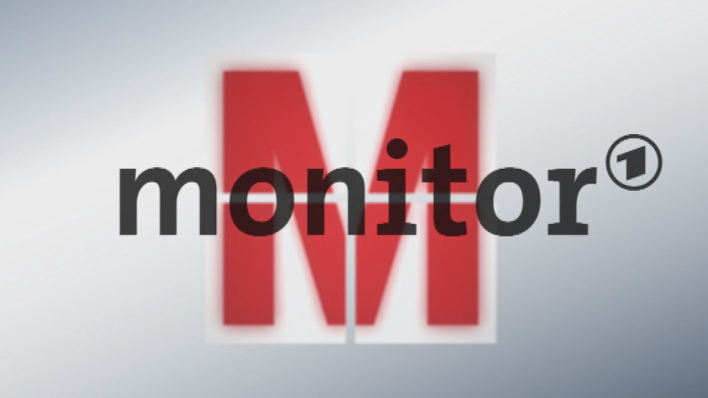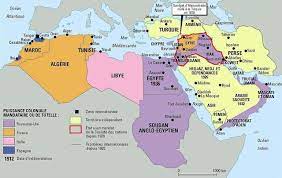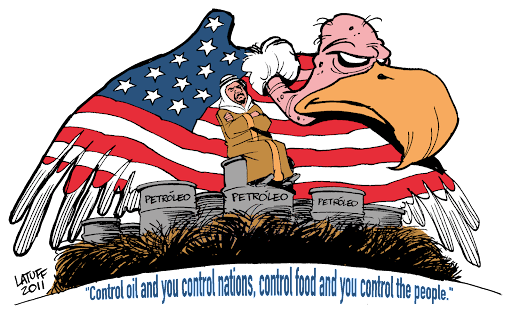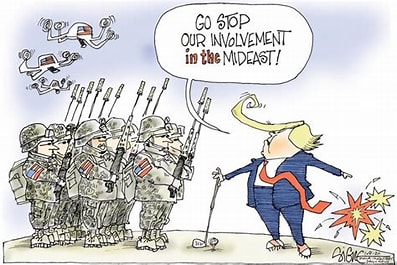A Decline in US Middle East Power Results in Regional Unity
Posted by INTERNATIONALIST 360° on
Iran-Saudi peace has been subsequently followed by Saudi negotiations with Yemen’s Ansarallah government, to end the war that erupted back in 2015 and has claimed the lives of around 400,000 Yemenis.
Ever since the 1940’s the United States government has opposed and eventually thwarted all attempts for Middle East nations to unify towards the region’s interests. Despite Washington’s pronouncements that its hegemonic influence was for the advancement of democracy, the decline of its power has ushered in a new wave of peace and compromise.
With the eruption of the war in Ukraine, back in February of 2022, and the imposition of sanctions against Moscow, what was once thought to be the unmatchable power of the US regime began to crumble in the eyes of the world. Not only have US sanctions failed to cripple Russia, but they have inflicted great blowback on Europe, in addition to opening up new opportunities for economic alliances that fall outside of Washington’s domain.
The US’s catastrophic failure, during its hasty evacuation of forces from Afghanistan, provided optics tantamount to those present during its 1975 withdrawal from Saigon, in Vietnam. Back then the message to the Global South was that victory against the US war machine is possible, however, the overarching lesson that emanated from the 2021 Afghanistan withdrawal was that Washington had overstretched itself and this signaled a change of an era.
A Wave of Middle East Unity
What emerged as the shock of the Islamic Republic of Iran’s restoration of ties with Saudi Arabia, brokered by China, has seemingly birthed a wave of compromise, peace negotiations, and revival of ties, between former regional foes. The fact that Beijing was the one to facilitate the Tehran-Riyadh rapprochement spoke volumes about the fading role of Washington in the Middle East, for decades a region that it viewed as part of its own backyard.
The Saudis had been provided with US military protection, as it was termed, since the first Iraq war back in 1990, allowing them to entrench themselves inside Saudi Arabia and other neighboring countries, all under the guise of combating Saddam Hussein at the time. The role of the United States, across the Middle East, was to sow division and place the region under its thumb. Due to the US owning the position as being the sole world power for so long, this seemed to be what fed into the decisions of many States to follow its orders; as those who refused were usually invaded or subject to coup d’etat and economic war.
Iran-Saudi peace has been subsequently followed by Saudi negotiations with Yemen’s Ansarallah government, to end the war that erupted back in 2015 and has claimed the lives of around 400,000 Yemenis. Now, Syria is being further integrated back into the Arab world, with Tunisia being the latest to formally reestablish diplomatic relations. Saudi Arabia’s Foreign Minister, Prince Faisal bin Farhan Al Saud, also arrived in Damascus in order to meet with Syrian President Bashar al-Assad.
Then we have the re-opening of ties between Qatar and Bahrain, which was followed by an announcement in Doha that Qatar is set to restore diplomatic ties with the United Arab Emirates (UAE) and re-open embassies, after a long bitter dispute.
Perhaps the most significant development on its way, could be the possibility of Turkey-Syria rapprochement. In the event that Damascus officially normalizes ties with Ankara, this would provide for much more than opportunities for economic revival inside Syria. Although the war in Syria has come to a somewhat standstill, Turkish troop presence in the northwest is a buffer to the Syrian government recapturing the territory without a final peace settlement. Most crucially, however, is the effect that normalization may have on northeastern Syria, where the United States illegally occupies roughly a third of Syria’s territory, with the help of the Kurdish-led Syrian Democratic Forces (SDF).
If Turkey-Syria relations are mended and Turkish President, Recep Tayyip Erdogan, decides to conduct another military operation against the SDF in northeastern Syria, it is likely that US forces stationed in that territory will once again leave. In 2018 and 2019, when Turkish forces invaded Syrian territory to fight SDF armed groups, the US military deserted their Kurdish allies, likely fearing an escalation with their NATO ally Turkey. In 2019, the Turkish military incursion allowed for the capture of a small pocket in the north of Syria, during which the US army pulled out its service members from Syria before sending them back after the escalation was finished. At that time, the Syrian government had attempted diplomacy and sent in its own troops to find a solution but did not muster an offensive against any side.
The importance of the third of Syrian territory, under the de facto occupation of the US, is due to this being the territory where Syria’s most fertile agricultural lands and 90% of their oil resources happen to be located. If Turkey and Syria normalize ties, then Turkey attacks the SDF again, and the possibility of a US troop withdrawal or retreat is high, under this scenario, Damascus and Ankara would be able to directly communicate. This would provide for an opportunity for a Syrian Arab Army offensive to retake their oil fields, at a time where any US resistance would be weak and likely limited to strikes from a distance. After the oil fields are recaptured, there is no reason for the US to return to Syria and mounting a full-scale war would be too costly, in addition to being unpopular domestically.
A future in the Middle East, where US power can be limited, seems to be proving better for regional stability and productivity at this moment. Although Washington constantly markets itself as the bringer of peace, the second their power begins to recede, it becomes apparent that they have been the single largest barrier to peace in the Middle East.
The Collapse of US Policy in the Middle East
Posted by INTERNATIONALIST 360° on
Now, it is abundantly clear that the United States’ dishonest and aggressive Middle East strategy, which is at odds with the aspirations of the Arab world, has utterly failed. The establishment of a multipolar world by Russia, China, and Iran was a significant milestone in this process. The convergence of these three nations and the global support for this new diplomatic triangle have been impossible for the United States and its allies to prevent.
End of Road for the U.S. as Saudi Arabia Chooses to Decouple | Vantage with Palki Sharma
Firstpost 14.03.2023 #palkisharma#vantageonfirstpost#firstpost

End of Road for the U.S. as Saudi Arabia Chooses to Decouple from Washington | Vantage with Palki Sharma. Saudi Arabia wants to play a bigger role in the world. Its ambitions are growing, and it is undergoing a transition – both an economic and social one. The US does not figure in Saudi’s scheme of things as Riyadh turns to China and Russia. Palki Sharma tells you more.
Die Vormachtstellung (der USA) im Mittleren Osten 19.04.2018 – Bananenrepublik


Während die Welt auf Syrien schaut, haben die Falken in Washington längst Größeres im Sinn: Es geht um die Vormachtstellung im Mittleren Osten in den kommenden Jahrzehnten. Die Strategie der US-Amerikaner: Regime Change oder zumindest militärische Schwächung des Erzfeindes Iran. Dessen Feinde, insbesondere Saudi-Arabien, werden dafür massiv aufgerüstet – auch mit Hilfe Deutschlands. Ein Spiel mit dem Feuer, das Frieden und Sicherheit in weite Ferne rücken lässt.

Jochen Hippler
Intervention, Demokratie, Kontrolle –Die US-Politik im Mittleren Osten als pdf-Datei
Geschichtliche Voraussetzungen
Vorbereitung direkter Militärintervention
Die strategischen Grundinteressen der USA
Die Politik Washingtons im Nahen und Mittleren Osten wird – vor allem in den letzten Jahren – häufig mit moralischen und wertegestützten Argumenten begründet („Freiheit“, „Demokratie“), beruht aber tatsächlich auf drei Kerninteressen:
- der zum großen Teil innenpolitisch nahe liegenden Unterstützung Israels,
- der Wahrung der Stabilität der Region und US-freundlicher Regime, was sich früher in einer Politik der Schwächung der regionalen Rolle der Sowjetunion äußerte, heute die Unterstützung von den USA nahestehenden Regimen und die Konfrontation mit vorgeblichen „Schurkenstaaten“ einschließt;
- und den strategischen Interessen einer Kontrolle der energiepolitischen Schlüsselregion des Persischen Golfes, wobei das Augenmerk sich inzwischen auch auf die energiereichen Regionen am Kaspischen Meer und in Zentralasien erweiterte.
Diese drei Interessendimensionen ergänzen sich nicht automatisch, sondern können durchaus in Widersprüche geraten: So kann sich die grundsätzliche Unterstützung Israels zwar auf breite innenpolitische Unterstützung (inzwischen auch aus Kreisen fundamentalistischer Christen, die der Republikanischen Partei nahe stehen, etwa der Strömung der „Christlichen Zionisten“ oder nach der Einschätzung des Fernsehpredigers Jerry Falwell, wonach die besonders christlich geprägten Landesteile „das Sicherheitsnetz Israels“ seien) und eine teilweise ideologische Nähe zur israelischen Politik stützen (insbesondere deren anti-iranische und anti-syrische Tendenz), untergräbt aber häufig die regionale Stabilität, wenn Washington z.B. die israelische Besatzungspolitik in Palästina oder dessen Krieg gegen den Libanon (2006) faktisch unterstützt. Eine solche Politik kann auch weiter entfernte, pro-amerikanische arabische Regime in Schwierigkeiten bringen, die so bei der eigenen Bevölkerung diskreditiert werden. Die prinzipielle Positionierung an der Seite Israels macht auch die Politik zur Kontrolle der Ölregion am Persischen Golf nicht leichter.
Hier soll stärker auf die Bedeutung der Energiesicherung als Kerninteresse US-amerikanischer Regionalstrategie eingegangen werden. Das US-Interesse an Ölimporten hat sich in den letzten Jahrzehnten deutlich erhöht. Standen beispielsweise 1970 einem US-Verbrauch von 14,7 Millionen barrel (ein Fass von 159 Liter) pro Tag noch 11,7 Millionen barrel eigener Ölproduktion gegenüber (die USA produzierten also fast 80 Prozent ihres Ölbedarf im eigenen Land), so hatte sich dies bis zur Jahrtausendwende entscheidend geändert. Im Jahr 2000 verbrauchten die USA 19,7, förderten aber nur noch 9,1 Millionen barrel pro Tag, also etwas mehr als 46 Prozent des Eigenbedarfs. In dieser Zeit ging der Anteil der USA an der Weltölproduktion von 23,9 auf 11,8 Prozent zurück, während der am weltweiten Verbrauch nur von 31,4 auf 26 Prozent sank. Zugleich drängten andere Länder massiv auf den Energiemarkt: China verbrauchte 2004 fast die dreifache Menge Öl wie 1990 und damit schon zweieinhalb mal so viel wie Deutschland.
Die USA decken gegenwärtig ihren eigenen Importbedarf nur zum kleineren Teil im Nahen und Mittleren Osten. Ihre wichtigsten Lieferanten für Rohöl sind Kanada (rund 2 Mill. barrel pro Tag), Mexiko (knapp 1,5 Mill.), Saudi Arabien (1,4), Venezuela (1,1), Nigeria (0,9) und der Irak (knapp 0,6 Mill. barrel pro Tag, dicht gefolgt von Angola; alle Zahlen aus dem November 2006).
Nun darf aus dieser geographischen Verteilung allerdings nicht geschlossen werden, dass die USA vom Öl des Persischen Golfes und den Vorkommen in Zentralasien unabhängig wären – der Ölmarkt ist global, und bei einer Situation teilweise bereits sinkender Fördermengen und deutlich wachsender Nachfrage (gerade durch China und andere asiatische Länder) werden der Golf und Zentralasien zukünftig an wirtschaftsstrategischer Bedeutung eher noch zunehmen. Sieht man sich die nachgewiesenen Ölreserven auf der Welt an, wird dies noch unterstrichen. Von den sechs Ländern mit den größten Ölreserven liegen fünf am Persischen Golf, nämlich Saudi Arabien (nachgewiesene Ölreserven von 263 Mrd. barrel, fast 20 Prozent der Weltreserven), Iran (133 Mrd. barrel; 10 Prozent der weltweiten Ölvorkommen), Irak (113), Vereinigte Arabische Emirate (98), und Kuwait (97; zusammen weitere fast 23 Prozent der Weltölvorkommen). Nehmen wir noch Katar (16 Mrd. barrel), den Oman (6) und die nicht am Golf gelegenen Länder der Großregion hinzu (Libyen: 40; Kasachstan: 26; Algerien: 12; Jemen: 4 Mrd. barrel), dann ergibt sich bereits heute die überragende Bedeutung des Nahen und Mittleren Ostens für die Weltenergieversorgung. Bedacht werden muss dabei auch, dass in einer Reihe dieser – und anderer– Länder auch Erdgas in großer Menge vorhanden ist.
Einer Supermacht wie den USA, die zunehmend von Ölimporten abhängig wird, kann eine solche Region deshalb nicht gleichgültig sein. Die berühmte Formulierung von Henry Kissinger (ehemaliger Nationaler Sicherheitsberater und danach Außenminister der USA), „Öl ist ein viel zu wichtiges Gut, als dass man es den Arabern überlassen könnte“, die von zwei ehemaligen UNO-Diplomaten berichtet wird, bringt eine in Washington verbreitete Sichtweise deutlich auf den Punkt. Aber den USA geht es nicht darum, die Ölvorkommen der Region einfach militärisch zu besetzen und das Öl abzupumpen, sondern um ihre strategische Dominanz. Der damalige US-Präsident George Bush Senior erklärte dies vor dem Golfkrieg von 1991, als es um die irakische Besetzung Kuwaits ging:
„Der Irak selbst kontrolliert etwa 10 Prozent der Welterdölreserven. Mit Kuwait kontrolliert er die doppelte Menge. Ein Irak, dem es gestattet wäre, Kuwait zu schlucken, würde die wirtschaftliche und militärische Macht, aber auch die Arroganz besitzen, seine Nachbarn einzuschüchtern und unter Druck zu setzen – Nachbarn, die den Löwenanteil der übrigen Welterdölreserven kontrollieren. Wir können es nicht zulassen, dass solch lebenswichtige Bodenschätze von jemandem beherrscht werden, der so rücksichtslos handelt. Und wir werden es nicht zulassen.“
Es geht bei der Politik der US-Administration gegenüber dem Golf zwar um Öl – aber nicht darum, den Fluss des Öls physisch bzw. direkt militärisch zu sichern. Das ist kaum nötig, da das Öl der Region bereits zum Verkauf steht: Alle Länder müssen es aus wirtschaftlichen Gründen exportieren, dazu zwingen braucht man sie nicht. Es geht auch kaum um die militärische Senkung der Ölpreise – das wird von Politikplanern in Washington gelegentlich als Ziel formuliert, ist aber durch militärische Dominanzpolitik oder Krieg kaum zu erreichen. Ganz im Gegenteil: Der Golfkrieg von 1990/91 führte dazu, den Ölpreis pro barrel von 17 auf über 45 Dollar zu erhöhen, konnte diesen Anstieg zumindest nicht verhindern. Auch 2003 bestand diese Gefahr: das Wall Street Journal (20. Dezember 2002) wies bereits vor Kriegsbeginn darauf hin, dass gerade angesichts der Streiks in der Ölindustrie Venezuelas ein kriegsbedingter Ausfall der irakischen Exporte das Preisniveau weiter heben müsste – insbesondere angesichts der Entscheidung der OPEC, ab dem 1. Januar 2003 die Produktion um 1,7 Mill. barrel pro Tag zu kürzen. Bereits kurz darauf stieg der Ölpreis um rund 20% auf rund 30 Dollar. Nach dem Irakkrieg von 2003 erreichte er tatsächlich neue Höhen von zeitweise über 70 Dollar.
Das Politikziel besteht also weder in der physischen Eroberung des Öls noch in einer direkten Marktregulierung (im Sinne einer erzwungenen Preissenkung) durch Krieg, sondern tatsächlich in dem, was Präsident Bush erläutert hatte: der Verweigerung einer Vormachtstellung am Golf durch irgendeine nicht befreundete Macht. Weder der Irak noch der Iran (Saudi Arabien kommt dafür kaum in Frage, die Sowjetunion ist ausgeschieden, Russland fehlt hier das Gewicht) durften oder dürfen nach dieser Ansicht die geostrategisch wichtige Region dominieren. (Dies war natürlich noch anders, als bis 1978 der befreundete Schah den Iran regierte – damals wurde er gezielt zum regionalen Stellvertreter der USA aufgerüstet.) Das beste Mittel, fremden Einfluss oder gar Vorherrschaft dauerhaft zu verhindern ist, die Region selbst politisch und militärisch zu dominieren.
Das starke US-Interesse am Persischen Golf basiert auf seinem Energiereichtum, auf seiner Bedeutung für die Weltwirtschaft durch die Ölvorkommen – aber eben nicht auf eine direkte und ungebrochene Art und Weise, sondern politisch vermittelt. Ein „Krieg für Öl“ ist dies aus Washingtoner Sicht deshalb nur indirekt (ganz im Gegensatz zur damaligen Eroberung Kuwaits durch den Irak, die tatsächlich vor allem aus wirtschaftlichen Gründen erfolgte), sondern ein Kampf, die reichen Energieressourcen des Golfs nicht zur Basis einer fremden Machtausdehnung werden zu lassen und zugleich am Golf einen politisch stabilen Rahmen eigener Hegemonie zu etablieren, der die regionalen Öl-Exporteure quasi naturwüchsig an die USA bindet, ohne den Fluss des Öls selbst kontrollieren zu müssen. Zugleich wird eine eindeutige US-Dominanz in der Region den USA strategische Positionsvorteile gegenüber anderen großen Ölimporteuren verschaffen, die dort zwar über noch stärkere wirtschaftliche Interessen, aber kaum politischen Einfluss verfügen.

Karin Leukefeld: „… weil es nicht so läuft, wie die USA sich das vorgestellt haben“

P. Rapke: Welche Rolle spielen der Iran und der Jemen in den geostrategischen Plänen der USA und welche Pläne sind das?
Karin Leukefeld: Die Region in der Iran und Jemen liegen ist eine Region reich an Rohstoffen, Öl und Gas, und sie ist eine strategisch wichtige Region für Transportwege. Also 25% der weltweiten Erdölvorkommen sind in dieser Region der arabischen Halbinsel und der Iran hat ja auch sehr große Vorkommen. Wir haben westlich der Arabischen Halbinsel
das Rote Meer und den Suezkanal, sehr wichtige Transportwege. Und wir haben östlich der Arabischen Halbinsel den Persischen Golf mit Zugang zu den Erdölfeldern im Süden des Irak, Kuwaits, Bahrain
, Katar. Das sind alles sehr wichtige Ressourcen und Europa aber auch die USA sind Abnehmer des Öls und des Flüssiggases aus Katar. Um diese Region weiter zu sichern, gibt es diesen militärischen Aufmarsch in dieser Region schon seit dem 2. Weltkrieg. Es geht weiter zurück bis in die Kolonialzeit. Frankreich, Großbritannien im 19. Jahrhundert. Das hat natürlich auch damit zu tun, dass die Situation in Syrien nicht so läuft, wie sich die USA das vorgestellt haben.
P. Rapke: Es sieht so aus als würden die USA eine Art Entscheidungsschlacht herbeiführen wollen, ökonomisch und vielleicht auch militärisch. Nicht nur im Nahen Osten sondern global. Warum ausgerechnet jetzt?
Karin Leukefeld: Das hat unterschiedliche Aspekte. Es gibt einen innenpolitischen Aspekt in den USA. Die Administration ist ja in sich gespalten. Es gibt unterschiedliche Ansatzpunkte im Außenministerium, im Pentagon und im Weißen Haus, es gibt Konkurrenz und Widersprüche. Und es hat einen regionalen Aspekt mit der Situation in Syrien und im Irak, weil es mit dem Sturz der Regierung in Damaskus auf der einen Seite und den politischen Veränderungen im Irak zugunsten des Iran nicht so läuft, wie die USA sich das vorgestellt haben. Der Iran hat einfach sehr viel mehr Einfluss in der Region bekommen – im Grunde seit der völkerrechtswidrigen US-amerikanischen Intervention 2003.
Auf der anderen Seite gibt es eben den wachsenden Einfluss Russlands, also die Stärkung Russlands in der Region. Last but not least hat es natürlich mit China zu tun. Die Region ist Teil des Neuen Seidenstraßen Projektes von China und gerade die Häfen im Persischen Golf, im Roten Meer, der Suezkanal, die Häfen der Levante, also von Libanon und Syrien sind Teil dieses Projekts.
Wir befinden uns in einer Zeit, in der die Rohstoffe knapper werden und eine internationale Auseinandersetzung sich beschleunigt, um den Zugang zu den Rohstoffen und um ihre geostrategische Kontrolle. In diesem Zusammenhang muss man das sehen.


Schreibe einen Kommentar